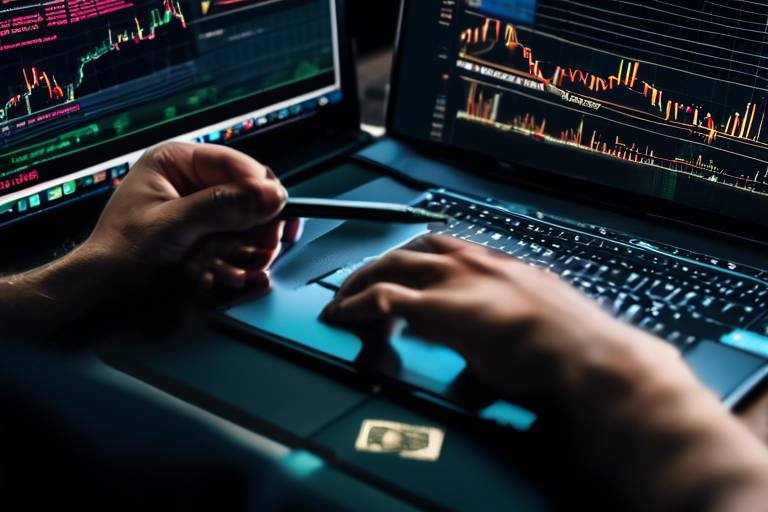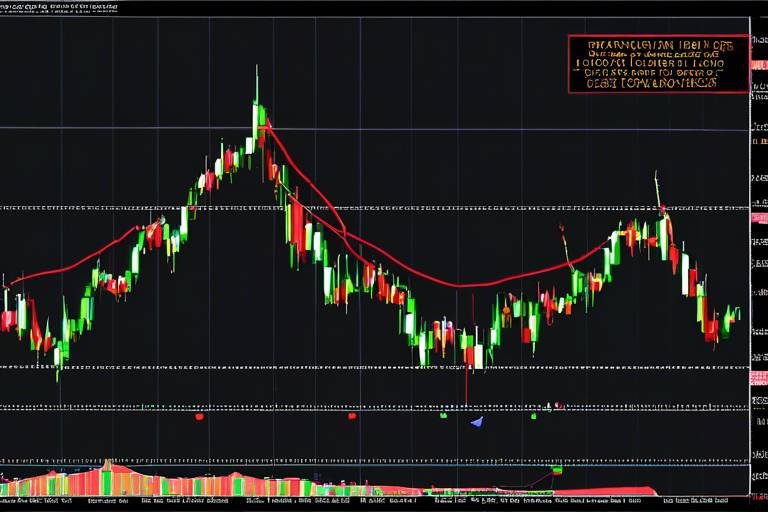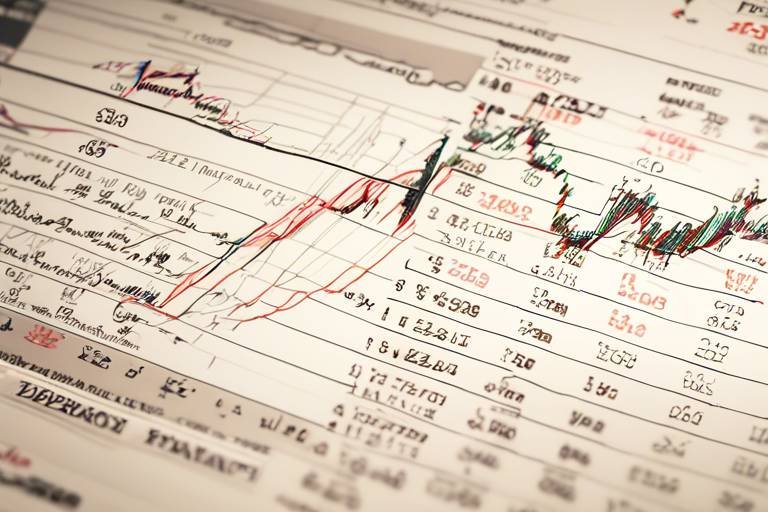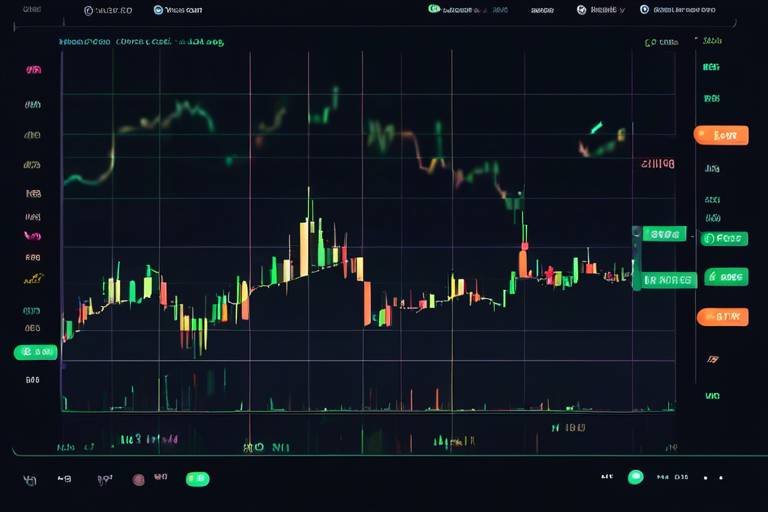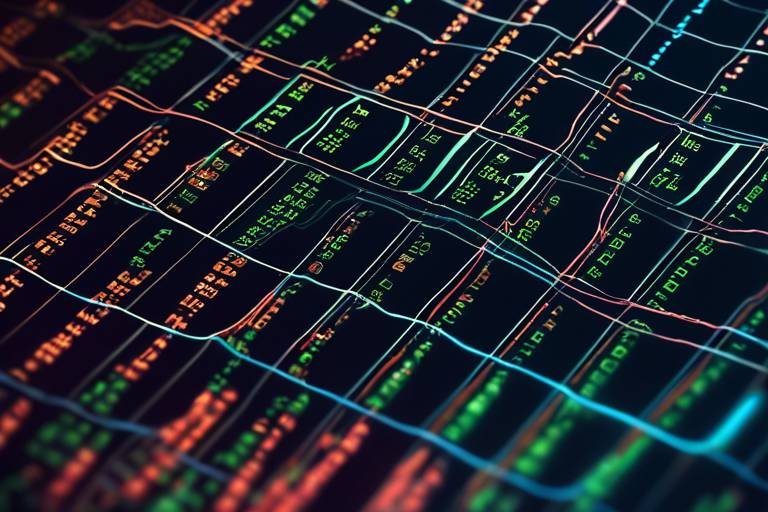How to Use Technical Analysis for Cryptocurrency Investment
In the fast-paced world of cryptocurrency, making informed investment decisions can feel like trying to catch smoke with your bare hands. With prices swinging wildly and trends shifting in the blink of an eye, how can you possibly navigate this chaotic landscape? Enter technical analysis, a powerful tool that can help you decipher the market's cryptic signals and enhance your investment strategy. By analyzing price movements and trading volumes, technical analysis provides a roadmap to forecast future price trends, allowing you to ride the waves of volatility instead of being swept away by them.
At its core, technical analysis is all about understanding the psychology of the market. It’s like being a detective, piecing together clues from historical price data to predict where the market might head next. This method is particularly relevant in the cryptocurrency space, where emotions often drive price fluctuations. By honing your skills in technical analysis, you can make more educated decisions rather than relying solely on gut feelings or news headlines.
So, how do you get started? First, familiarize yourself with the essential components of technical analysis, such as chart patterns and indicators. These tools can help you identify trends, reversals, and potential entry and exit points for your trades. Understanding these elements is crucial, as they can significantly enhance your investment decisions in the unpredictable crypto market.
As we delve deeper into the world of technical analysis, we’ll explore key chart patterns that traders rely on to gauge market sentiment. We'll also cover popular technical indicators that can provide additional insights into price movements. By the end of this article, you’ll be equipped with the knowledge to make more informed decisions and potentially boost your cryptocurrency investment outcomes.
Technical analysis involves evaluating price movements and trading volumes to forecast future price trends. By examining historical data, traders can uncover patterns that often repeat themselves, providing insights into market behavior. This section will delve into its principles and how it applies specifically to cryptocurrency investments.
When you look at a cryptocurrency chart, you’re not just seeing random squiggly lines; you’re witnessing the collective actions and emotions of countless traders. Each price movement tells a story, and technical analysis helps you read that narrative. Whether you’re a seasoned trader or a newcomer, understanding the basics of technical analysis can greatly enhance your ability to make sound investment choices.
Recognizing chart patterns is crucial for predicting price movements. Chart patterns act like road signs, guiding you through the twists and turns of the market. Some popular patterns include head and shoulders, triangles, and flags. Each of these patterns has its own significance in crypto trading, and understanding them can be the key to unlocking profitable trades.
The head and shoulders pattern is a classic formation that signals potential trend reversals. Imagine a mountain range with three peaks: the first peak is the left shoulder, the second and highest peak is the head, and the third peak is the right shoulder. This pattern indicates that the market is losing momentum, and a reversal may be on the horizon. Identifying this pattern can give traders a heads-up to exit their positions or prepare for a shift in market direction.
On the flip side, the inverse head and shoulders pattern indicates a bullish reversal. Picture a valley with three troughs: the first trough is the left shoulder, the second and deepest trough is the head, and the third trough is the right shoulder. This pattern suggests that after a downtrend, the market may be gearing up for a rally. Spotting this formation can be a game-changer for traders looking to capitalize on upward price movements.
Triangles represent consolidation periods in price action, where the market is building up energy for a breakout. An ascending triangle typically indicates bullish sentiment, while a descending triangle suggests bearish sentiment. Understanding these formations can help traders anticipate breakout points, allowing them to position themselves advantageously before significant price movements occur.
Volume is a critical factor in confirming trends. It’s not enough to just look at price movements; you also need to analyze trading volumes to gauge the strength of a trend. High volume during a price increase indicates strong buying interest, while high volume during a price decrease suggests strong selling pressure. By analyzing trading volumes alongside price movements, you can make more informed investment decisions in cryptocurrencies.
Technical indicators assist traders in making data-driven decisions. These indicators can provide additional insights and help confirm patterns you may have identified. Some essential indicators include Moving Averages, Relative Strength Index (RSI), and MACD. Understanding how to apply these indicators can significantly enhance your trading strategy.
Moving averages smooth out price data to identify trends over a specified period. They act like a safety net, helping you filter out the noise of daily price fluctuations. Different types of moving averages, such as the simple moving average (SMA) and the exponential moving average (EMA), can provide varying insights into market trends. By tracking these averages, traders can identify potential entry and exit points based on trend changes.
The RSI measures the speed and change of price movements, providing insights into overbought or oversold conditions in cryptocurrencies. Think of it as a thermometer for market sentiment. When the RSI reaches extreme levels, it can signal a potential reversal. By incorporating RSI into your analysis, you can better time your trades and avoid getting caught in price traps.
- What is technical analysis? Technical analysis is the study of past market data, primarily price and volume, to forecast future price movements.
- How do I identify chart patterns? Familiarize yourself with common patterns and practice recognizing them on charts using historical data.
- What indicators should I use? Popular indicators include Moving Averages, RSI, and MACD, each serving different purposes in analysis.
- Is technical analysis effective for cryptocurrencies? Yes, technical analysis can be very effective in the volatile cryptocurrency market, but it should be used in conjunction with other analysis methods.

Understanding Technical Analysis
Technical analysis is like having a crystal ball for the cryptocurrency market—well, sort of! It involves evaluating price movements and trading volumes to forecast future price trends. This method is not just some mystical art; it’s based on real data and patterns that traders can observe over time. In the world of cryptocurrency, where prices can swing wildly in a matter of minutes, technical analysis becomes an essential tool in a trader's kit. By analyzing historical price data, traders can make informed predictions about where the market might head next. Think of it as reading the market’s mood through its past actions.
The principles of technical analysis are rooted in three main ideas: price discounts everything, price moves in trends, and history tends to repeat itself. When we say that "price discounts everything," we mean that all available information—news, earnings, and market sentiment—is already reflected in the price. This is crucial because it implies that by examining price movements alone, you can get a clearer picture of what traders are thinking.
Next, the idea that "price moves in trends" is fundamental. Prices don't just fluctuate randomly; they often follow trends—upward, downward, or sideways. Recognizing these trends can help traders make educated guesses about future movements. And finally, the notion that "history tends to repeat itself" is the backbone of chart patterns. Traders believe that patterns formed in the past can reappear, providing clues about future behavior.
In the volatile realm of cryptocurrencies, technical analysis can be particularly beneficial. Unlike traditional markets, crypto markets operate 24/7, making it essential for traders to stay on top of price movements. By utilizing technical analysis, traders can identify potential entry and exit points, manage risk, and make data-driven decisions rather than emotional ones. This analytical approach can help demystify the chaos of the crypto market, turning what seems like random price fluctuations into understandable trends.
To get started with technical analysis, traders often use various tools and resources. Here are some common elements that play a significant role:
- Charts: The visual representation of price movements over time, providing insights into trends and patterns.
- Indicators: Mathematical calculations based on price, volume, or open interest that help traders make sense of market conditions.
- Volume Analysis: Assessing the number of shares or contracts traded to gauge the strength of a price movement.
In summary, understanding technical analysis is like learning a new language in the world of cryptocurrency. It equips you with the tools to interpret market signals, make informed decisions, and potentially enhance your investment returns. By grasping the fundamentals of price movements and trading volumes, you can navigate the often turbulent waters of the crypto market with greater confidence.

Key Chart Patterns
When it comes to navigating the unpredictable waters of cryptocurrency trading, understanding can be your compass. Chart patterns are visual representations of market psychology and can provide crucial insights into potential price movements. By recognizing these patterns, traders can make more informed decisions, enhancing their chances of success in the volatile crypto market. Let's dive into some of the most significant chart patterns that every crypto investor should know.
The head and shoulders pattern is one of the most reliable indicators of a potential trend reversal. This pattern typically forms after an uptrend and consists of three peaks: the left shoulder, the head, and the right shoulder. The left shoulder is created when the price rises to a peak and then declines, followed by a higher peak (the head) and another decline. Finally, the right shoulder forms when the price rises again but fails to reach the height of the head before declining once more. Recognizing this pattern can signal to traders that a bearish trend may be on the horizon, prompting them to consider selling or shorting their positions.
On the flip side, the inverse head and shoulders pattern indicates a bullish reversal. This pattern is essentially the opposite of its counterpart and appears after a downtrend. It consists of three troughs: the left shoulder, the head, and the right shoulder, where the head is the lowest point. Identifying this formation can be a game changer for traders looking to capitalize on potential upward price movements. When the price breaks above the neckline that connects the peaks of the shoulders, it often signals a strong buying opportunity.
Triangles are another essential set of patterns that represent periods of consolidation in price action. The ascending triangle is characterized by a horizontal resistance line at the top and an upward-sloping support line at the bottom. This pattern often suggests that buyers are gaining strength, and a breakout above the resistance level could lead to significant price increases. Conversely, the descending triangle features a horizontal support line and a downward-sloping resistance line. This pattern typically indicates that sellers are in control, and a breakdown below the support level may result in further price declines. Understanding these triangles can provide traders with critical insights into potential breakout strategies.
Volume analysis is an integral part of understanding chart patterns. It helps traders confirm the strength of a pattern and the likelihood of a breakout or reversal. For instance, if a head and shoulders pattern forms with increasing volume, it strengthens the case for a trend reversal. Conversely, if the volume is low during a breakout, it might indicate a lack of conviction among traders, making the breakout less reliable. Keeping an eye on volume alongside chart patterns can significantly enhance your trading strategy and help you make more informed decisions.

Head and Shoulders Pattern
The is one of the most recognized and reliable chart patterns in technical analysis, particularly in the world of cryptocurrency trading. This pattern typically signals a potential reversal in the current trend, making it an essential tool for traders looking to make informed decisions. So, how does this pattern form, and what does it mean for your trading strategy? Let's break it down.
The head and shoulders pattern consists of three peaks: a higher peak (the head) flanked by two lower peaks (the shoulders). This formation can be visualized as a mountain range with a prominent peak in the center. The left shoulder forms after a price increase, followed by a peak that represents the head, and then a decline, leading to the right shoulder. Once the price breaks below the neckline—drawn by connecting the lows of the two shoulders—a bearish reversal is confirmed. This is where the magic happens; traders often see this as a signal to sell or short the asset.
To illustrate this pattern, consider the following diagram:
Head
/\
/ \
/ \
/ \
/ \
/ \
/ \
Left Shoulder Right Shoulder
But wait, it gets better! The inverse head and shoulders pattern is the flip side of this formation, indicating a bullish reversal. This pattern forms in a downtrend, where the price creates three troughs, with the middle trough being the deepest. Recognizing both the head and shoulders and the inverse head and shoulders patterns can significantly enhance your trading strategy, allowing you to capitalize on potential market shifts.
So, why should you care about these patterns? Understanding the head and shoulders pattern can provide you with a competitive edge in the highly volatile cryptocurrency market. By identifying these formations early, you can make timely decisions that could potentially save or earn you significant amounts of money. Additionally, combining this pattern with other technical indicators can lead to even more robust trading strategies.
In summary, the head and shoulders pattern serves as a crucial signal for traders. It not only helps in identifying potential reversals but also assists in defining entry and exit points. As you dive deeper into the world of cryptocurrency trading, keep an eye out for this pattern, and consider integrating it into your trading toolkit.
- What does the head and shoulders pattern indicate?
The head and shoulders pattern indicates a potential reversal in the price trend, suggesting that a bullish trend may be turning bearish. - How can I identify a head and shoulders pattern?
Look for three peaks: two lower peaks (shoulders) on either side of a higher peak (head), along with a neckline that connects the lows of the shoulders. - What is the significance of the neckline?
The neckline acts as a critical support level; a break below this line confirms the reversal signal.

Inverse Head and Shoulders
The inverse head and shoulders pattern is a powerful signal in the world of cryptocurrency trading, indicating a potential bullish reversal. Imagine a mountain range where the left shoulder and right shoulder are lower peaks, while the head is the tallest peak in the middle. This visual metaphor helps traders recognize the formation and understand its implications. To identify this pattern, you need to look for three distinct troughs: the first trough (left shoulder), a deeper trough (head), and a final trough (right shoulder) that is similar in depth to the first. When you spot this formation, it's like finding a treasure map leading to a potential price surge!
So, why is this pattern so significant for traders? When the price breaks above the neckline formed by connecting the highs of the two shoulders, it often signals a strong upward momentum. This breakout can lead to substantial price gains, making it an essential tool in your trading arsenal. However, it’s crucial to confirm this breakout with other indicators to avoid false signals. For instance, you might want to check the volume accompanying the breakout; ideally, you want to see a surge in volume, confirming that the market is indeed supporting this bullish move.
Here’s a quick breakdown of how to spot and trade the inverse head and shoulders pattern:
- Identify the Pattern: Look for the three troughs as described earlier.
- Draw the Neckline: Connect the highs of the two shoulders to form the neckline.
- Wait for the Breakout: Look for a price movement above the neckline.
- Confirm with Volume: Ensure that the breakout is supported by increased trading volume.
- Set Your Targets: Measure the distance from the head to the neckline and project it upward from the breakout point to set your price targets.
In conclusion, mastering the inverse head and shoulders pattern can significantly enhance your trading strategy. By recognizing this pattern early and confirming it with volume, you can position yourself advantageously in the volatile cryptocurrency market. Just remember, like any other trading strategy, it’s essential to use this pattern as part of a broader trading plan that considers risk management and market conditions.
What is the inverse head and shoulders pattern?
The inverse head and shoulders pattern is a technical analysis formation that indicates a potential bullish reversal in price trends, characterized by three troughs with the middle one being the deepest.
How do I trade the inverse head and shoulders pattern?
To trade this pattern, identify the three troughs, draw the neckline, wait for a breakout above the neckline, confirm with volume, and set your price targets based on the distance from the head to the neckline.
Can the inverse head and shoulders pattern fail?
Yes, like any trading pattern, the inverse head and shoulders can produce false signals. It’s crucial to confirm the breakout with additional indicators and volume to reduce risk.

Ascending and Descending Triangles
The world of cryptocurrency trading is as dynamic as it is unpredictable, and understanding price patterns can give you a significant edge. Among the various chart formations, stand out as powerful indicators of potential price movements. These patterns are not just random squiggles on a chart; they represent market psychology and the ongoing battle between buyers and sellers. Recognizing these formations can help traders anticipate breakouts and make informed decisions.
Let’s start with the ascending triangle. This pattern typically forms during an uptrend and is characterized by a horizontal resistance line at the top and an upward-sloping support line at the bottom. As the price approaches the resistance level, it often bounces off the support line, creating a series of higher lows. This tightening price action indicates that buyers are becoming increasingly aggressive, which can lead to a breakout above the resistance level. The breakout is often accompanied by increased volume, confirming the strength of the move. Traders often view this pattern as a bullish signal, suggesting that the price is likely to rise significantly after the breakout.
On the flip side, we have the descending triangle, which generally appears during a downtrend. This pattern features a horizontal support line at the bottom and a downward-sloping resistance line at the top. As the price approaches the support level, it tends to bounce off the resistance line, creating a series of lower highs. This indicates that sellers are becoming more dominant, and the pressure builds up as the price nears the support level. A breakout below this support line can signal a strong bearish trend, prompting traders to consider short-selling opportunities. Just like with ascending triangles, volume plays a crucial role in confirming the breakout direction.
To illustrate the differences between these two patterns, let’s take a look at a quick comparison table:
| Pattern Type | Formation | Market Sentiment | Breakout Direction |
|---|---|---|---|
| Ascending Triangle | Higher lows and horizontal resistance | Bullish | Upward |
| Descending Triangle | Lower highs and horizontal support | Bearish | Downward |
Understanding these patterns is just the beginning; the real challenge lies in effectively incorporating them into your trading strategy. When you spot an ascending triangle, it's wise to set your entry point just above the resistance line, with a stop-loss positioned below the most recent swing low. Conversely, for a descending triangle, consider entering a short position just below the support line, with a stop-loss above the most recent swing high. By using these patterns in conjunction with other technical indicators, such as volume analysis, you can enhance your decision-making process and potentially increase your profitability.
In conclusion, mastering ascending and descending triangles can significantly elevate your trading game. These patterns not only help in predicting potential price movements but also provide insights into market sentiment. As you dive deeper into the world of technical analysis, remember that practice makes perfect. Keep your eyes peeled for these formations, and soon, you'll be better equipped to navigate the thrilling yet tumultuous waters of cryptocurrency trading.
- What is the importance of triangle patterns in cryptocurrency trading? Triangle patterns help traders identify potential breakout points, providing insights into market sentiment and future price movements.
- How can I confirm a breakout from a triangle pattern? Look for an increase in trading volume accompanying the breakout; this often signals the strength of the move.
- Can triangle patterns be used in other markets? Yes, triangle patterns are common in various financial markets, including stocks and forex, making them versatile tools for traders.
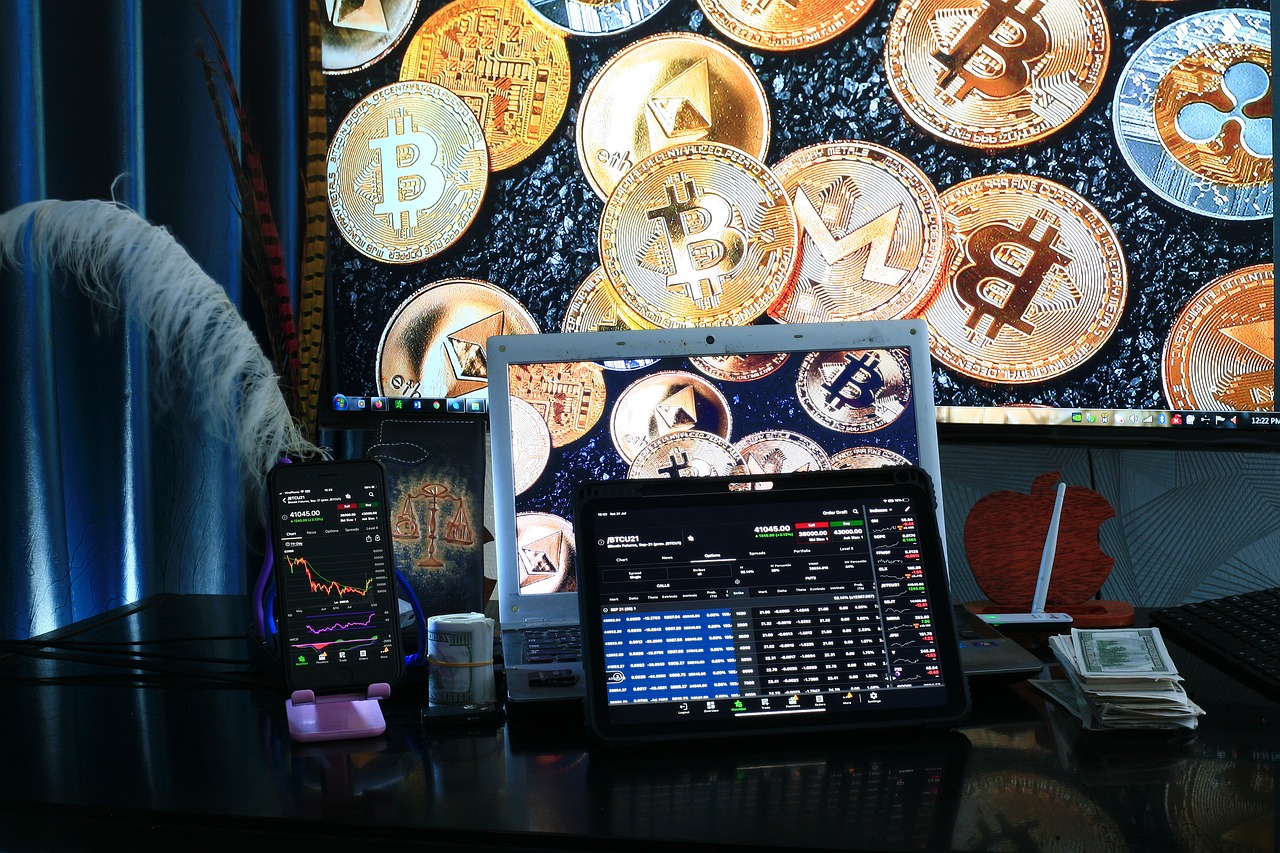
Volume Analysis
When diving into the world of cryptocurrency trading, understanding is like having a compass in a dense fog. It helps you navigate through the chaotic waves of price movements. Essentially, volume refers to the number of coins that have been traded over a specific period. It acts as a confirmation tool for price trends; in other words, it tells you whether a price move is genuine or just a fleeting moment. Imagine trying to lift a heavy object. If you have a friend helping you, the effort is more substantial and likely successful. Similarly, high trading volume during a price increase suggests that many traders are buying in, indicating a strong trend, while low volume may signify a lack of interest or conviction.
To make sense of volume analysis, consider these critical points:
- Volume Spikes: A sudden increase in volume can signal a potential breakout or reversal. For instance, if Bitcoin's price suddenly jumps, but the volume remains low, it may not be sustainable.
- Volume Trends: Analyzing volume over time can reveal patterns. For example, rising prices accompanied by increasing volume often indicate a healthy trend, while rising prices with declining volume may suggest a potential reversal.
- Volume and Support/Resistance Levels: Volume can also help identify key support and resistance levels. If a price approaches a resistance level with high volume, it may break through; conversely, if it approaches with low volume, it might bounce back.
To illustrate the importance of volume analysis, let’s take a look at a hypothetical scenario involving Ethereum:
| Date | Price (ETH) | Volume (ETH) |
|---|---|---|
| October 1 | $3,000 | 2,000 |
| October 2 | $3,050 | 2,500 |
| October 3 | $3,100 | 3,000 |
| October 4 | $3,150 | 1,500 |
In this table, you can see that while the price of Ethereum is steadily increasing, the volume on October 4 dropped significantly. This dip in volume could indicate a potential weakening of the upward trend, prompting traders to be cautious. Always remember, volume is your ally; it can confirm your assumptions or lead you to rethink your strategies.
In conclusion, mastering volume analysis is essential for making informed trading decisions in the cryptocurrency market. By understanding how volume interacts with price movements, you can enhance your strategies and potentially increase your profitability. It's not just about the price; it's about the story that volume tells. So, next time you analyze a crypto chart, don't forget to pay close attention to the volume—it might just be the key to unlocking your trading success!
1. What is volume analysis in cryptocurrency trading?
Volume analysis involves examining the number of coins traded over a specific period to confirm trends and price movements.
2. Why is volume important?
Volume is crucial as it provides insight into the strength of a price trend. High volume during price increases suggests strong buying interest, while low volume may indicate weakness.
3. How can I use volume to improve my trading strategy?
By incorporating volume analysis, you can identify potential breakouts, reversals, and key support and resistance levels, allowing for more informed trading decisions.
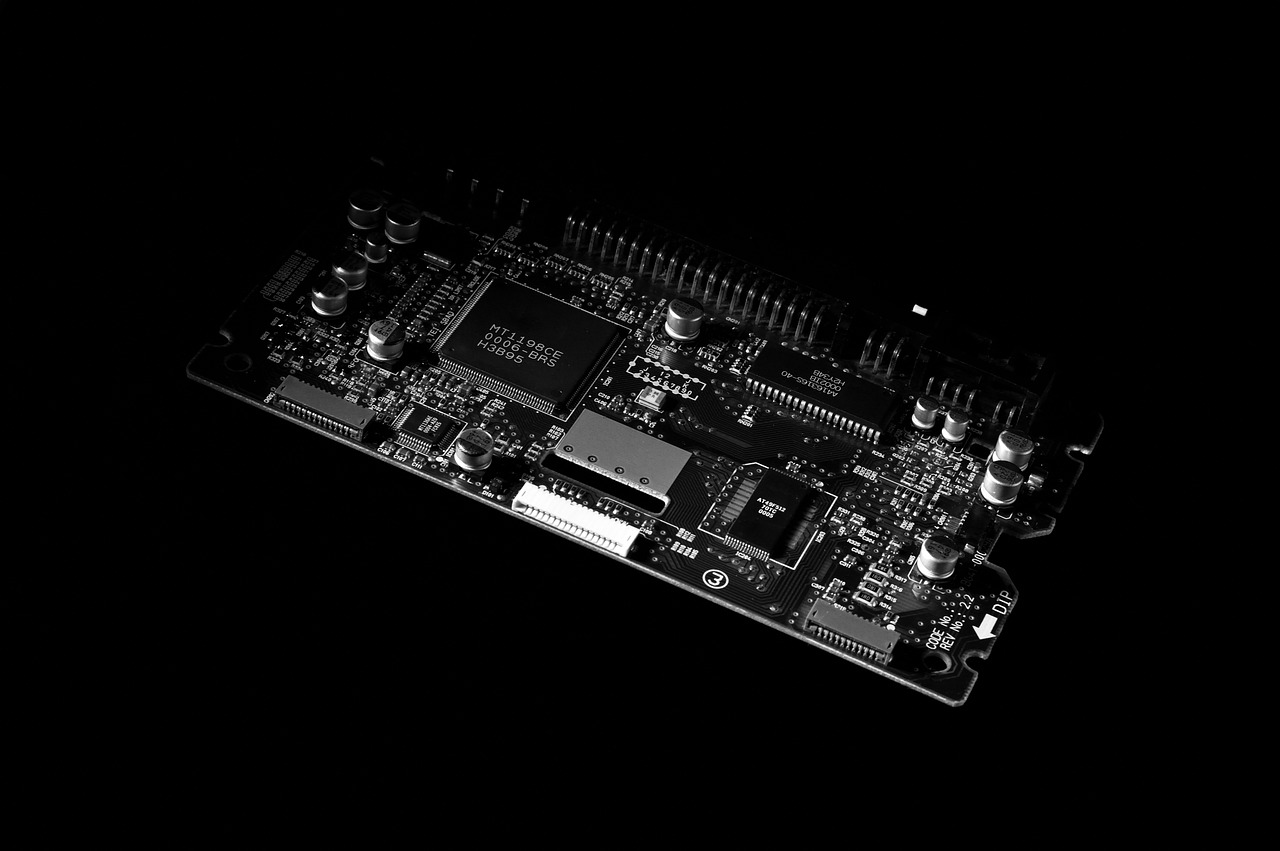
Popular Technical Indicators
When diving into the world of cryptocurrency trading, it's essential to equip yourself with the right tools to make informed decisions. One of the most effective ways to do this is through the use of technical indicators. These indicators help traders analyze market trends and price movements, allowing them to predict future price behavior with greater accuracy. Think of them as your trusty compass in the chaotic sea of crypto trading. They guide you in making data-driven decisions rather than relying solely on gut feelings.
Among the myriad of indicators available, a few stand out as particularly useful for cryptocurrency traders. Each of these indicators has its own unique function and can significantly enhance your trading strategy. Here are three of the most popular indicators you should consider:
- Moving Averages (MA)
- Relative Strength Index (RSI)
- Moving Average Convergence Divergence (MACD)
Let’s break these down a bit further.
Moving averages are a fundamental tool in technical analysis, serving to smooth out price data over a specified time period. They help traders identify trends by filtering out the "noise" from random price fluctuations. There are two primary types of moving averages: the Simple Moving Average (SMA) and the Exponential Moving Average (EMA). The SMA calculates the average price over a set number of periods, while the EMA gives more weight to recent prices, making it more responsive to new information.
Here’s a quick comparison of the two:
| Type | Calculation Method | Responsiveness |
|---|---|---|
| Simple Moving Average (SMA) | Averages prices over a specific number of periods | Less responsive |
| Exponential Moving Average (EMA) | Gives more weight to recent prices | More responsive |
Traders often use moving averages in conjunction with other indicators to confirm trends or identify potential reversals. For instance, a common strategy is to look for crossovers between short-term and long-term moving averages.
The Relative Strength Index (RSI) is another vital indicator that measures the speed and change of price movements. It ranges from 0 to 100 and is typically used to identify overbought or oversold conditions in a market. An RSI above 70 usually indicates that a cryptocurrency is overbought, while an RSI below 30 suggests it is oversold. This can be particularly useful for traders looking to time their entries and exits effectively.
Imagine walking through a crowded market; if everyone is buying, prices are likely to rise, but if no one is buying, prices might drop. The RSI helps you gauge this market sentiment, acting as a barometer for potential price corrections.
The MACD is a trend-following momentum indicator that shows the relationship between two moving averages of a security’s price. It consists of three components: the MACD line, the signal line, and the histogram. Traders use the MACD to identify potential buy and sell signals. When the MACD line crosses above the signal line, it may indicate a bullish trend, while a crossover below could suggest a bearish trend.
Using these indicators in tandem can provide a more comprehensive view of the market. For example, if the RSI shows an asset is oversold and the MACD indicates a bullish crossover, it might be an opportune moment to buy. However, as with any strategy, it’s crucial to conduct thorough research and consider other factors before making investment decisions.
1. What are technical indicators?
Technical indicators are statistical calculations based on price, volume, or open interest of a security. They help traders analyze market trends and make informed decisions.
2. How do I choose the right indicators for my trading strategy?
Choosing the right indicators depends on your trading style and goals. Experiment with different indicators and see which ones align with your strategy and provide the most valuable insights.
3. Can I rely solely on technical indicators for trading?
While technical indicators are valuable tools, it's essential to combine them with other forms of analysis, such as fundamental analysis, to make well-rounded trading decisions.

Moving Averages
are fundamental tools in technical analysis, particularly in the realm of cryptocurrency trading. They help traders smooth out price data to identify trends over a specific period. By averaging past prices, moving averages not only reduce the noise in price charts but also provide a clearer view of the prevailing market direction. Imagine trying to read a book while someone is constantly flipping the pages; that's what price volatility feels like. Moving averages help you focus on the storyline by filtering out the distractions.
There are several types of moving averages, each serving a unique purpose in trading strategies:
- Simple Moving Average (SMA): This is the most basic type of moving average, calculated by adding the closing prices of a cryptocurrency over a set period and then dividing by that number of periods. For example, a 10-day SMA takes the average of the last 10 days' closing prices.
- Exponential Moving Average (EMA): Unlike the SMA, the EMA gives more weight to the most recent prices, making it more responsive to new information. This can be particularly useful in the fast-paced crypto market, where prices can change dramatically in a short time.
- Weighted Moving Average (WMA): Similar to the EMA, the WMA assigns different weights to prices, but it does so in a linear fashion. This means that more recent prices have a greater impact on the average than older prices.
Utilizing moving averages can provide traders with significant insights into market trends. For instance, when the price of a cryptocurrency crosses above its moving average, it can signal a potential bullish trend, while a cross below may indicate a bearish trend. Traders often look for crossovers between different moving averages, such as the 50-day and 200-day averages, to identify long-term trends. This strategy is known as the Golden Cross when the shorter moving average crosses above the longer one, and the Death Cross when it crosses below.
To illustrate how moving averages work, consider the following table that compares the SMA and EMA for a hypothetical cryptocurrency over a 5-day period:
| Day | Closing Price | SMA (5-day) | EMA (5-day) |
|---|---|---|---|
| 1 | $100 | $100 | $100 |
| 2 | $105 | $102.5 | $100.67 |
| 3 | $110 | $105 | $102.89 |
| 4 | $115 | $107.5 | $104.80 |
| 5 | $120 | $110 | $108.40 |
As you can see from the table, the SMA provides a straightforward average, while the EMA reacts more quickly to price changes. This characteristic can be crucial for traders looking to enter or exit positions swiftly in the volatile crypto market.
In conclusion, moving averages are not just numbers on a chart; they are vital indicators that can guide your trading decisions. Whether you're a seasoned trader or a newcomer to the crypto scene, understanding and utilizing moving averages can enhance your ability to navigate the unpredictable waters of cryptocurrency investment.

Relative Strength Index (RSI)
The is a powerful momentum oscillator that measures the speed and change of price movements. Developed by J. Welles Wilder Jr., this indicator ranges from 0 to 100 and is primarily used to identify overbought or oversold conditions in a market. But what does that really mean for cryptocurrency traders? Imagine you're on a roller coaster; the RSI helps you determine whether the ride is about to drop or climb again based on how steep the recent price changes have been.
Typically, an RSI above 70 indicates that a cryptocurrency is overbought, suggesting that the price might be due for a correction. Conversely, an RSI below 30 signals that the asset is oversold, hinting at potential upward momentum. This oscillation can serve as a crucial signal for traders looking to enter or exit positions. But wait, how do we actually apply this information? Let's break it down further.
To effectively use RSI in your trading strategy, you should consider the following steps:
- Identify the Trend: Before diving into RSI readings, assess the overall market trend. Is the cryptocurrency in a bullish or bearish phase? This context is vital for interpreting the RSI correctly.
- Look for Divergences: One of the most potent signals RSI can provide is divergence between the price action and the RSI itself. For instance, if the price is making new highs while the RSI is failing to reach new highs, this could indicate a potential reversal. This is akin to a sprinter who starts slowing down while the finish line is still far away—a warning sign!
- Combine with Other Indicators: While RSI is a robust tool, it shines even brighter when used alongside other technical indicators. For example, pairing RSI with Moving Averages can help confirm trends or reversals, giving you a more comprehensive view of the market.
It’s also important to remember that no indicator is foolproof. The RSI can generate false signals, especially in highly volatile markets like cryptocurrency. Therefore, it’s wise to use it in conjunction with other forms of analysis and risk management strategies. Think of it as a compass on a hiking trip; it guides you, but you still need to pay attention to the terrain and weather conditions around you.
In summary, the is an essential tool in the arsenal of any cryptocurrency trader. By understanding its signals and how to interpret them, you can make more informed decisions and potentially increase your chances of success in the unpredictable world of crypto investing. Whether you're a seasoned trader or just starting out, mastering the RSI can give you a significant edge in your trading strategy.
Here are some common questions traders have about the Relative Strength Index:
- What is a good RSI level to buy? Generally, an RSI below 30 may indicate a buying opportunity, but always consider the broader market context.
- Can RSI be used in all markets? Yes, while RSI is popular in stocks and forex, it is also highly applicable to cryptocurrencies.
- How often should I check the RSI? It depends on your trading strategy. Day traders might check it frequently, while swing traders may look at it daily or weekly.
Frequently Asked Questions
- What is technical analysis in cryptocurrency?
Technical analysis is a method used to evaluate and predict the future price movements of cryptocurrencies by analyzing historical price data and trading volumes. It helps traders make informed decisions based on market trends and patterns.
- How do I identify chart patterns?
Identifying chart patterns involves looking for specific formations in price charts, such as head and shoulders, triangles, and flags. Each pattern has its own significance and can indicate potential price movements, helping traders to anticipate market shifts.
- What is the head and shoulders pattern?
The head and shoulders pattern is a reversal pattern that signals a potential change in trend direction. It consists of three peaks: a higher peak (head) between two lower peaks (shoulders). Recognizing this pattern can help traders make strategic decisions about buying or selling.
- What does the inverse head and shoulders pattern indicate?
The inverse head and shoulders pattern suggests a bullish reversal. It appears as three troughs, with the middle trough being the lowest. Spotting this pattern can signal an opportunity for traders to enter a position before a price increase.
- How can I use volume analysis in trading?
Volume analysis involves examining the number of shares or contracts traded during a specific period. By analyzing volume alongside price movements, traders can confirm trends and make better-informed investment decisions. High volume during a price increase typically indicates strong buying interest.
- What are moving averages and why are they important?
Moving averages are indicators that smooth out price data to identify trends over a specific period. They help traders understand the general direction of the market and can signal potential entry or exit points based on crossovers between different moving averages.
- What is the Relative Strength Index (RSI)?
The RSI is a momentum oscillator that measures the speed and change of price movements on a scale of 0 to 100. It helps traders identify overbought or oversold conditions in the market, allowing them to make more informed decisions about when to buy or sell cryptocurrencies.
- How can I start using technical analysis for cryptocurrency investment?
To start using technical analysis, familiarize yourself with chart patterns and indicators. Practice analyzing historical price data, and consider using trading platforms that offer technical analysis tools. Over time, you'll develop the skills needed to make data-driven investment decisions.

